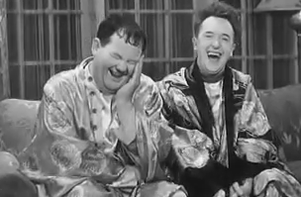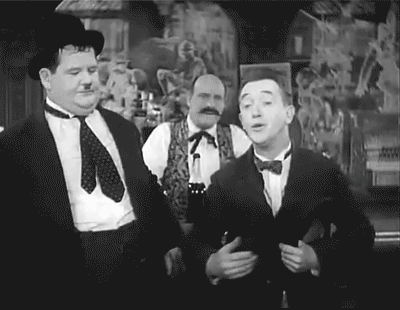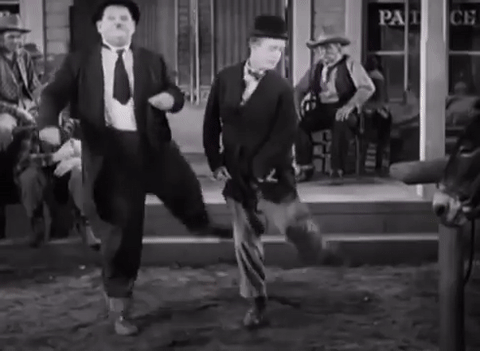Em 13 de março de 1927, um
curta-metragem chamado “Duck Soup” estreou e mudou as carreiras de Stan Laurel
e Oliver Hardy para sempre. Ambos já eram comediantes estabelecidos, embora
algo desiludidos, mas estavam prestes a se tornar não apenas ídolos do público,
mas lendas do cinema.
On March 13th, 1927, a short film called “Duck
Soup” was released and it changed the careers of Stan Laurel and Oliver Hardy
forever. Both were already established comedians, yet a little sour with their
little success, but they were about to become not only movie idols, but also
film legends.
Norvell Hardy nasceu na Georgia em
1892. Em 1913, já usando o nome Oliver, que era o primeiro nome do seu pai,
Hardy entrou no cinema por trás das câmeras. Primeiro, ele abriu sua própria
sala de cinema - Hardy foi o mais jovem gerente de sala de cinema nos Estados
Unidos!
Mudando-se para a Florida, para os
estúdios Lubin, Hardy se tornou responsável por varias coisas, como objetos de
cena e iluminação. Ele apareceu em seu primeiro filme em 1914.
De 1914 a 1926, Hardy fez centenas de
filmes, geralmente como coadjuvante e quase sempre como valentão, vilão ou
personagem muito nervoso.
Norvell Hardy was born in Georgia in 1892. In 1913,
already using the name Oliver, that was his father’s first name, Hardy entered
the movie business behind the cameras. First, he opened his own movie theater -
Hardy was the youngest movie theater manager in the United States!
Moving to the Lubin studio in Florida, Hardy became
responsible for several things, like props and lighting. He appeared in his
first film in 1914.
From 1914 until 1926, Hardy made hundreds of films,
often as a supporting character and usually as a bully, villain or really
nervous character.
Stan antes de Ollie / Laurel before Hardy
Arthur Stanley Jefferson nasceu em
Lancashire, Inglaterra, em 1890. Ele veio de uma família do teatro, foi uma
criança tímida, fez sua estreia nos palcos quando tinha quase 16 anos e, aos
19, foi contratado pela companhia de Fred Karno como substituto de um cara
chamado Charles Chaplin.
Em 1912 a companhia fez um tour pelos
EUA, e Stan decidiu ficar por lá - Chaplin só migraria para os EUA dois anos
depois. Stan trabalhou no teatro por cinco anos, e em 1917 fez sua primeira
aparição no cinema.
Stan normalmente era “escada” para as
piadas de outros comediantes - como Larry Semon - e em seus filmes de meados
dos anos 1920 já é possível vê-lo interpretando personagens ingênuos.
Arthur Stanley Jefferson was born in Lancashire,
England, in 1890. He came from a theater family, was a shy kid, made his stage
debut when he was about to turn 16 and, at 19, was employed by Fred Karno’s
company as an understudy for a little fella called Charles Chaplin.
In 1912 the company toured the US, and Stan decided
to stay - Chaplin would only migrate to the US two years later. Stan worked in
theater the five following years, and in 1917 he made his first film appearance.
Stan often played second fiddle to other comedians
- such as Larry Semon - and in films from the mid-1920s it’s already possible
to see him playing naïve characters.
O primeiro encontro: The Lucky Dog (1921) / The
first meeting: The Lucky Dog (1921)
Algumas coisas são questão de timing,
não de ocasião. Por exemplo: no primeiro filme juntos, “The Lucky Dog” (1921):
Oliver Hardy roubou, espancou e ameaçou Stan Laurel com uma arma. Neste filme.
“Stanley Laurel” era um homem que havia sido recém-despejado de uma hospedaria,
e encontrava um vira-lata que o ajudava a conquistar uma jovem rica. “Babe
Hardy” era um ladrão.
“The Lucky Dog” foi filmado alguns
anos antes, provavelmente em 191. Podemos afirmar isso por causa da maquiagem
nos olhos de Stan - tendência chamada de “kohl eyes” - algo que ele usava
apenas nos seus primeiros filmes na década de 1910.
O segundo filme deles foi “45 Minutes
From Hollywood” (1926), mas eles não tinham cenas juntos.
Some things are a matter of timing, not chance. For
instance: in their first screen appearance together, in “The Lucky Dog” (1921),
Oliver Hardy robbed, punched and threatened Stan Laurel with a gun. In this
film, “Stanley Laurel” was a man who had just been expelled from a boarding
house, and found a stray dog that helped him conquer a young heiress. “Babe
Hardy” was a thief.
“The Lucky Dog” was shot a few years earlier,
probably in 1919. We can say that because of Stan’s strong eye makeup- “kohl eyes” -, something he used only in his earlier movies of the 1910s.
Their second film was “45 Minutes From Hollywood”
(1926), but they didn’t appear in scenes together.
A
dupla e o legado / The duo and the legacy
Em 1926, tanto Laurel quanto Hardy
foram contratados por Hal Roach - Laurel como roteirista, Hardy como
coadjuvante. Normalmente se diz que quem sugeriu que eles formassem uma dupla
foi Leo McCarey, então funcionário de Hal Roach. Roach preferia dizer que foi
ele mesmo que juntos os extremos para fazer rir. Não importa
quem foi. A parceria funcionou. E como!
In 1926, both Laurel and Hardy were hired by Hal
Roach - Laurel as a screenwriter, Hardy as a supporting player. It’s often said
that their pairing was suggested by Leo McCarey, then a Hal Roach employee.
Roach preferred to say it was him that brought the extremes together for
laughs. No matter who did it, the partnership worked. And how!
Laurel e Hardy fizeram tanto curtas
quanto longas-metragens, tanto filmes mudos quanto filmes falados, e
trabalharam em vários estúdios, como o de Roach, MGM e Fox. “Caixa de Música”
(1932), feito nos estúdios de Roach e distribuído pela MGM, é um curta-metragem
maravilhoso dirigido por James Parrott - irmão de Charley Chase - com gags
diversas, variadas e fugindo do óbvio. “Caixa de Música” ganhou o primeiríssimo
Oscar de Melhor Curta-metragem.
Laurel and Hardy did both short and feature films,
both silents and talkies, and worked in several studios, like Roach’s, MGM and
Fox. “The Music Box” (1932), made at Hal Roach studios and distributed by MGM,
is a superior short film directed by James Parrott - Charley Chase’s brother -
with several varied, not so obvious, gags. “The Music Box” went to win the
first ever Oscar for Best Short Film.
No cinema eles amavam comédia física
e slapstick, e também experimentaram com trocadilhos e humor verbal nos
longas-metragens. As histórias de Laurel e Hardy se expandiram para outros
meios, como histórias em quadrinhos e, mais tarde, desenhos animados - aliás,
Walt Disney gostava muito deles. Eles também eram favoritos nas redes de
televisão e nas reprises, e em alguns lugares ainda é possível encontrar filmes
deles sendo exibidos. Desta maneira, muitas gerações cresceram com Laurel
e Hardy.
In movies they loved physical comedy and slapstick,
and also experimented with puns and verbal humor in feature films. Laurel and
Hardy’s stories expanded to other media, such as comic books and, later,
cartoons- by the way, Walt Disney liked them very much. They were also
favorites for reruns on television and syndication, and in some places they are
exhibited until today. This way, many generations grew up with Laurel and
Hardy.
Mas há muitos de nós que não os
conhecemos como “Stan e Ollie”. Aqui no Brasil a duplo foi batizada de “O Gordo
e o Magro”, o mesmo nome dos países que falam espanhol (“El Gordo y El Flaco”).
Na Alemanha, eles eram “Dick und Doof” (“o Gordo e o Bobo”) e em Portugal,
“Bucha e Estica”.
But there are many of us who don’t know them as
“Stan and Ollie”. Here in Brazil the duo was baptized as “O Gordo e o Magro”,
the same as it was in Spanish-speaking countries (“El Gordo y El Flaco”). In
Germany, they were “Dick und Doof” (“Fat and Dumb”) and in Portugal they were
“Bucha e Estica” (slangs for someone fat and someone slim).
 |
| Brazilian cartoonist Angelo France transformed Timon and Pumbaa in Laurel and Hardy |
Não importa como você os chama, você
não pode negar que eles eram uma grande dupla. Não importa onde você vá, lá
você vai encontrar lembrancinhas, estátuas e muitas, muitas pessoas que têm
doces memórias envolvendo Laurel e Hardy.
No matter how you call then, you can’t deny they
were a great duo. No matter where you go, you can find memorabilia, statues and
many, many people with tender memories involving Laurel e Hardy.
This is my contribution to the Dynamic Duos in
Classic Film blogathon, hosted by Aurora and Annmarie at Once upon a Screen and
Classic Movie Hub.







4 comments:
You wrote a wonderful and informative piece on my favourite movie guys. Well done.
It is a comforting thing to realize that people all over the world still love Laurel and Hardy. Coming to success in the silent era meant their films were accessible internationally. When they moved to sound Roach Studios made their films for different language markets with different supporting casts and Stan and Oliver learning their lines phonetically.
Laurel & Hardy are still my favourite comedy team of all time. They had such wonderful chemistry and they also had perfect timing. Once a year in high school our science teacher would tell us that we would be covering some very important material the next day and not to miss it. It would never fail that he would show an old Laurel & Hardy short!
The Laurel and Hardy shorts are some of my very favorites. They never fail to cheer me up and make me laugh.
Awesome, my friend. Just seeing that first photo brought a big smile to my face. They are timeless and are a 100% prescription for making anyone feel better. Love those boys and your post.
Post a Comment